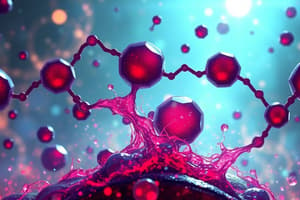Podcast
Questions and Answers
What is the primary structural feature of porphyrins that allows them to bind metal ions?
What is the primary structural feature of porphyrins that allows them to bind metal ions?
- The planar structure and polarized nitrogen atoms in the central cavity (correct)
- The presence of hydrogen atoms surrounding the nitrogen atoms
- The ability to be synthesized through various routes
- Their aromatic nature
Which of the following is NOT a common metal ion that can be complexed with porphyrins?
Which of the following is NOT a common metal ion that can be complexed with porphyrins?
- Iron
- Zinc
- Sodium (correct)
- Copper
What is the primary purpose of the metal ion in a metalloporphyrin complex in biological systems?
What is the primary purpose of the metal ion in a metalloporphyrin complex in biological systems?
- To serve as a signaling molecule
- To provide structural stability to the porphyrin
- To catalyze chemical reactions (correct)
- To increase the solubility of the porphyrin
Which of the following is NOT a common method for the synthesis of porphyrins?
Which of the following is NOT a common method for the synthesis of porphyrins?
Which of the following statements about the structure of porphyrins is INCORRECT?
Which of the following statements about the structure of porphyrins is INCORRECT?
Which of the following biological processes does NOT involve the use of metalloporphyrins?
Which of the following biological processes does NOT involve the use of metalloporphyrins?
Which of the following factors primarily determines the strength of the interaction between a metal ion and a porphyrin ring?
Which of the following factors primarily determines the strength of the interaction between a metal ion and a porphyrin ring?
Which of the following metal-porphyrin complexes is commonly used as a catalyst in the hydrogen evolution reaction for water electrolysis?
Which of the following metal-porphyrin complexes is commonly used as a catalyst in the hydrogen evolution reaction for water electrolysis?
Which of the following porphyrin derivatives plays a crucial role in the photosynthetic process in plants?
Which of the following porphyrin derivatives plays a crucial role in the photosynthetic process in plants?
Which of the following properties of porphyrins has led to their use as sensors for detecting various analytes?
Which of the following properties of porphyrins has led to their use as sensors for detecting various analytes?
Which of the following statements is true regarding the applications of porphyrin complexes in coordination chemistry?
Which of the following statements is true regarding the applications of porphyrin complexes in coordination chemistry?
Which of the following metal ions is not commonly found in porphyrin complexes?
Which of the following metal ions is not commonly found in porphyrin complexes?
Flashcards are hidden until you start studying
Study Notes
Porphyrins and Their Role in Coordination Chemistry
Porphyrins are macrocyclic aromatic organic compounds composed of 18 carbon atoms connected by four pyrrole rings. They contain nitrogen atoms at the 2, 4, 7, and 8 positions, making them planar, symmetrical molecules with a central cavity. Porphyrins are known for their ability to bind to metal ions, which is essential in many biological processes. This article explores the role of porphyrins in coordination chemistry.
Structure and Synthesis of Porphyrins
The structure of porphyrins consists of four pyrrole rings fused together, forming a macrocycle. The nitrogen atoms in the ring are surrounded by hydrogen atoms and can be replaced by other atoms or groups, such as iron, zinc, or copper. The central cavity of the porphyrin can accommodate a metal ion, forming a complex.
Porphyrins can be synthesized through various routes, such as the condensation of δ-amino acids, the Chichibabin reaction, or the McMurry coupling. These methods allow for the production of porphyrin derivatives with different substituents and metal complexes.
Binding Metals through Coordination
The central cavity of porphyrins is particularly suited for binding metal ions due to their planar structure and the presence of polarized nitrogen atoms. This ability is crucial in many biological processes, where metalloporphyrins play essential roles, such as in photosynthesis, oxygen transport, and electron transfer.
Metal ions can bind to the nitrogen atoms in the porphyrin ring through donor interactions, forming a coordination bond. The strength of this interaction depends on factors such as the size, charge, and geometry of both the metal ion and the porphyrin molecule. Common metal ions found in porphyrins include iron(II) (Fe^2+^), zinc(II) (Zn^2+^), copper(II) (Cu^2+^), nickel(II) (Ni^2+^), and magnesium(II) (Mg^2+^).
Applications in Coordination Chemistry
Due to their unique properties, porphyrins have numerous applications in coordination chemistry, including:
-
Catalysis: Porphyrin complexes can act as catalysts in reactions involving metal-mediated oxidations, reductions, and other chemical transformations. For example, Fe-porphyrin complexes have been used to promote the hydrogen evolution reaction in water electrolysis.
-
Photochemical Processes: Due to their ability to absorb and emit light, porphyrin complexes are involved in photochemical processes like photosynthesis and phototherapy. For instance, chlorophyll, which plays a vital role in plant photosynthesis, is a porphyrin derivative.
-
Sensors and Probes: Porphyrins can serve as sensors for certain chemicals or ions due to the change in their absorption spectra upon binding to specific analytes. This property has led to the development of porphyrin-based sensors for detecting heavy metals, drugs, gases, and other molecules.
In summary, porphyrins play a significant role in coordination chemistry due to their ability to bind metal ions and form stable complexes. These complexes have diverse applications in areas such as catalysis, photochemical processes, and sensing. As researchers continue to explore the potential of porphyrins, new discoveries and innovations are likely to emerge, further expanding our understanding and utilization of these fascinating molecules.
Studying That Suits You
Use AI to generate personalized quizzes and flashcards to suit your learning preferences.




